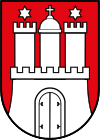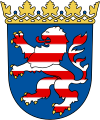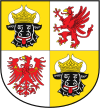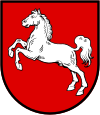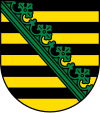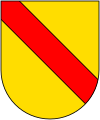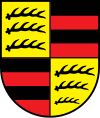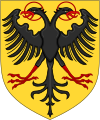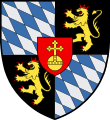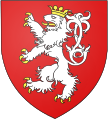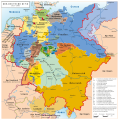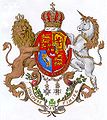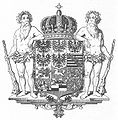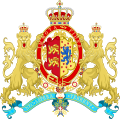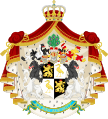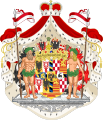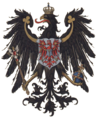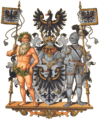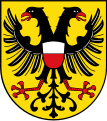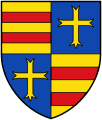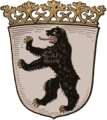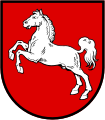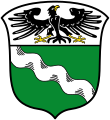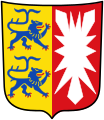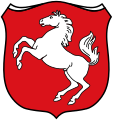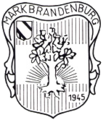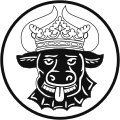List of coats of arms in Germany
This list contains the state and federal coats of arms of both the Federal Republic of Germany and the historical coats of arms of the German states . The navigation bar at the end of the article leads to the lists of the coats of arms of the individual countries.
The lists with the historical German coats of arms are not yet complete at this point in time. Sometimes these coats of arms can differ from the actual historical representations.
Federal Republic of Germany
Federal Republic of
Germany
Bundesschild
[Article]Federal Republic of
Germany
Federal Coat of Arms
[Article]
Coats of arms of the countries
The countries traditionally have national coats of arms , some in different designs: large, medium and small coats of arms. In the countries that have a large coat of arms with shield bearers, this is only used by the constitutional organs and the highest state authorities (e.g. state government, state parliament, state constitutional court, etc.).
Unlike the state coat of arms, as the national emblem legally protected emblems represent, should the so-called coat of arms , which derived from the crest logos or emblems are used not only by government agencies but also by businesses and citizens.
Coats of arms of the historical countries
On April 25, 1952, the states of Baden, Württemberg-Baden and Württemberg-Hohenzollern were merged into the newly founded state of Baden-Württemberg.
| Small coat of arms | Middle coat of arms | Great coat of arms | country | Further articles |
|---|---|---|---|---|
| to bathe | Baden's coat of arms | |||
| Württemberg-Hohenzollern | Coat of arms of Württemberg | |||
| Württemberg-Baden | Coat of arms of Württemberg / Baden |
Historical coat of arms
Holy Roman Empire

Original one-headed eagle, Codex Manesse
Quaternion eagle as an allegorical representation of the coats of arms of the members of the Holy Roman Empire, Jost de Negker (1510) converted into a vector graphic
Electorates from 1356 up to the main state deputation
Note: The exact design of the respective coats of arms has been subject to changes over the centuries. For the sake of clarity, the coats of arms shown here are exemplary.
Palatinate ; from 1544 with imperial orb → coat of arms of the Electoral Palatinate
Pfalz (1648- 1706 eighth as new electorship → causa palatina ); Crown never pictured in practice in protest
Saxony ; with imperial racing flag from 1371
Brandenburg ; with ore chamberlain from 1466
Bavaria (1623/48, transition of the old Palatinate electoral dignity to the Bavarian line of the Wittelsbachers ); contentious 1714- 1777
Braunschweig-Lüneburg / Hanover (1692); with crown from 1706
Electorates after the Reichsdeputationshauptschluss
The Reichsdeputationshauptschluss of 1803 abolished the two spiritual cures of Cologne and Trier, the Kurerzkanzler received the newly created Principality of Regensburg as a replacement for Mainz, which had been lost to France . Four imperial princes, on the other hand, received new electoral dignity. These were:
German Confederation 1815–1866
Members of the Federation
Note: Only the coats of arms of those states are listed that did not become part of the German Empire from 1871 or that had lost their independence by then.
Austrian Empire
1815Kingdom of
HanoverElectorate of
HesseLandgraviate of
HessePrincipality of
LiechtensteinDuchy of
NassauFree City of
Frankfurt
Lands of the Austrian Empire in the German Confederation
German Empire 1871–1918
The coat of arms of the German Empire always shows the eagle without a shield, in contrast to the coat of arms of the emperor.
States
Kingdoms
Kingdom of
Bavaria
large coat of armsKingdom of
Prussia
large coat of armsKingdom of
Württemberg
(1806-1817) Details
Kingdom of
Württemberg
Larger coat of arms
details
Grand duchies
Grand Duchy of
BadenGrand Duchy of
Hesse
(1808–1902)Grand Duchy of
Mecklenburg-SchwerinGrand Duchy of
Mecklenburg-StrelitzGrand Duchy of
OldenburgGrand Duchy of
Saxony-Weimar-Eisenach
Duchies
Duchy of
AnhaltDuchy of
Braunschweig
large coat of armsDuchy of
Braunschweig
small coat of armsDuchy of
Saxony-Altenburg
large coat of armsDuchy of
Saxony-Altenburg
Middle coat of armsDuchy of
Saxe-Coburg and Gotha
large coat of armsDuchy of
Saxe-Coburg and Gotha
Middle coat of armsDuchy of
Saxony-Meiningen and
Hildburghausen
large coat of armsDuchy of
Saxony-Meiningen and
Hildburghausen
Middle coat of arms
Principalities
Principality of
LippePrincipality of
Reuss older linePrincipality of
Reuss younger linePrincipality of
Schaumburg-LippePrincipality of
Schwarzburg-
RudolstadtPrincipality of
Schwarzburg-
Sondershausen
Free and Hanseatic cities
Reichsland
Reichsland
Alsace-Lorraine
Provinces of Prussia
City of
Berlin
Brandenburg province
large coat of arms
Brandenburg Province
Middle Coat of Arms
Brandenburg Province
Small coat of armsHanover Province
Hesse-Nassau Province
Province of
Hohenzollernsche LandProvince of
East PrussiaProvince
PomeraniaPoznan Province
Rhineland Province
Province of
SaxonyProvince of
SilesiaSchleswig-Holstein Province
Province of
WestphaliaWest Prussia Province
German Empire 1919–1933 (Weimar Republic)
German Reich
coat of arms
1919–1928German Reich
coat of arms
1928–1935German Reich
shield
countries
Free State of
AnhaltRepublic of
BadenFree State of
BavariaFree State of
BraunschweigFree Hanseatic City of
BremenFree and Hanseatic City of
HamburgPeople's State of
HesseFree State of
LippeFree and Hanseatic City of
LübeckFree State of
Mecklenburg-SchwerinFree State of
Mecklenburg-StrelitzFree State of
OldenburgFree State of
PrussiaFree State of
SaxonyFree State of
Schaumburg-LippeState of
ThuringiaFree State of
WaldeckPeople's State of
Württemberg
Prussian provinces
Imperial capital
Greater Berlin
Brandenburg Province
Hanover Province
Hesse-Nassau Province
Province
PomeraniaGrenzmark Province of
Posen-West PrussiaProvince of
East PrussiaRhineland Province
Province of
SaxonyProvince of
Lower SilesiaUpper Silesia Province
Schleswig-Holstein Province
Province of
Westphalia
German Empire 1933 to 1945
German Empire
1935–1945
State of
Württemberg
1933–1945
[Details]State of
Mecklenburg
1934–1945
[Details]
Other coats of arms identical to the section "German Empire 1919–1933 (Weimar Republic)"
German Democratic Republic
GDR national
coat of arms
January 12, 1950 to May 28, 1953GDR national
coat of arms
May 28, 1953 to September 26, 1955GDR national
coat of arms
1955–1990
[Details]
Countries (until 1952)
State of
Brandenburg
1945–1952
[Details]State of
Mecklenburg
1948–1952
[Details]State of
Saxony-Anhalt
1947–1952
[Details]
The state of Mecklenburg-Western Pomerania (since 1947 only Mecklenburg ) did not have a coat of arms. In 1948 it was agreed on the Mecklenburg bull's head as the seal of the country. The coats of arms submitted by then were discarded. After Mecklenburg-Western Pomerania was re-established in 1990, a coat of arms was finally established.
The federal states of the GDR were dissolved with the administrative reform in 1952 and replaced by 14 districts . These did not have coats of arms. Occasionally, however, the historical coats of arms of the district towns were used as symbols for the districts.
See also
- List of flags of German countries
- heraldry
- Official seal
- Heraldic sign
- Coats of arms of the German urban and rural districts
- Coats of arms of the states of the Federal Republic of Germany , German stamp series from 1992 to 1994











